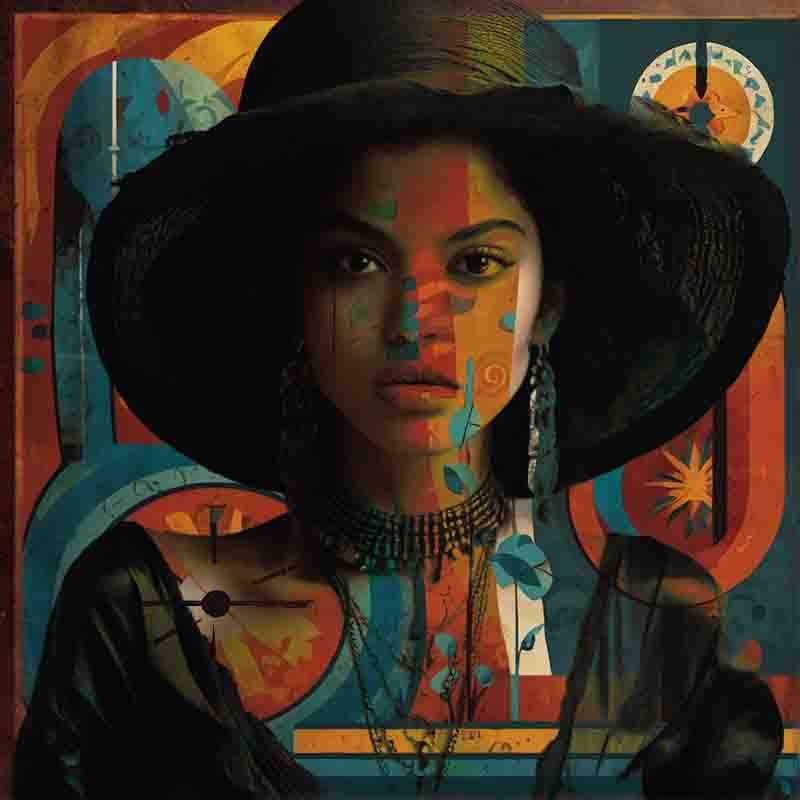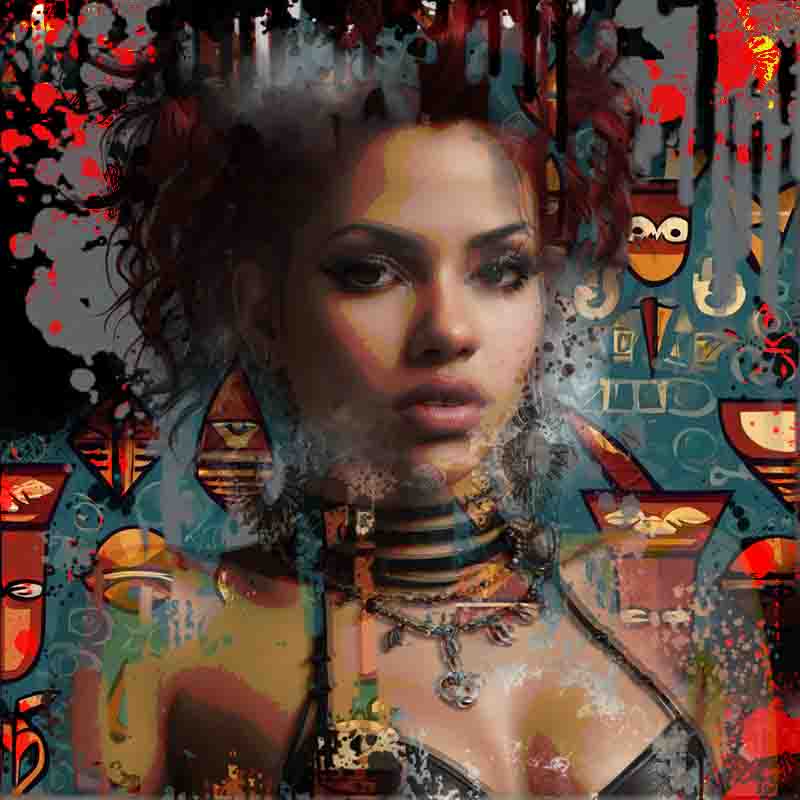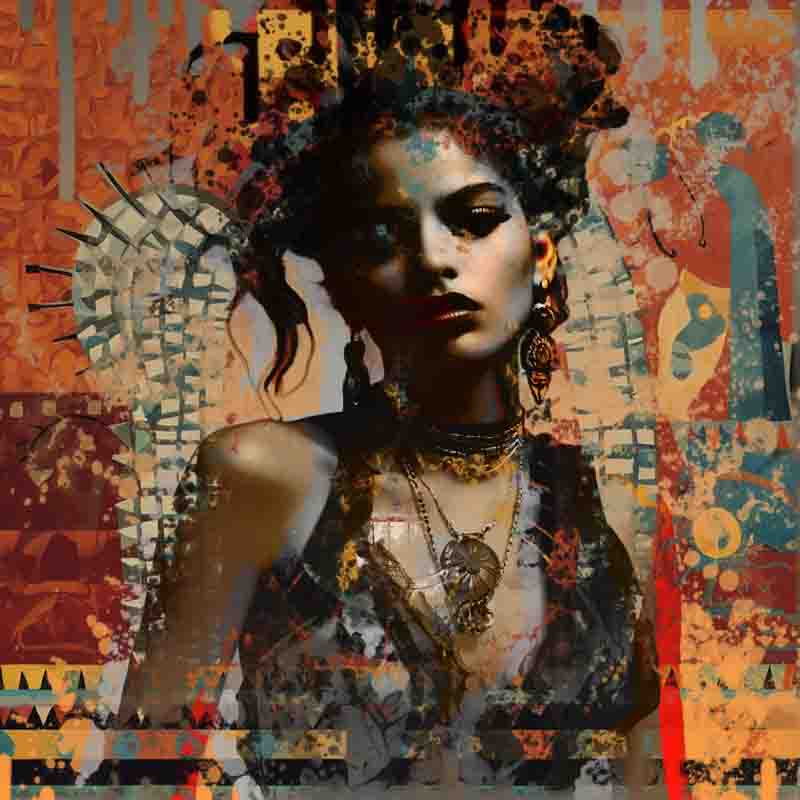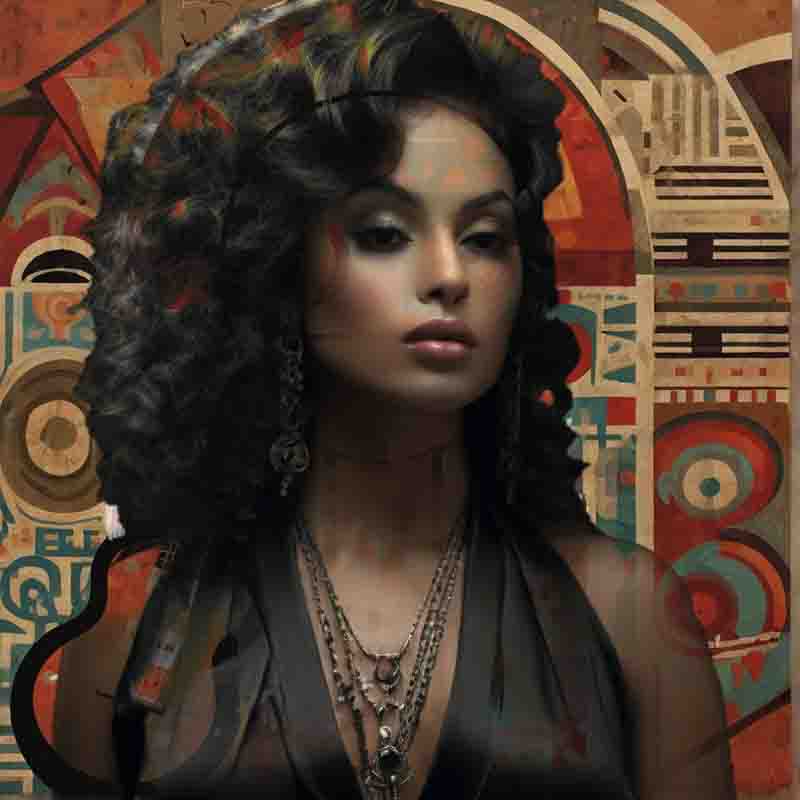Latin Rock as a Music Genre
Latin rock combines Latin American rhythms with the electrifying energy of rock'n'roll from the 1960s and 1970s, creating a captivating musical fusion. It blends rock guitars with traditional instruments such as congas and timbales, and uses elements and riffs found in son cubano, salsa, cumbia, bossa nova and merengue.
Latin Rock, a genre that marries the infectious beats of Latin American rhythms with the electrifying energy of Rock music, has taken the world by storm.
Pioneered by iconic bands and artists like Santana, Los Lobos, Maná, and Café Tacuba, Latin Rock has carved its place in music history, captivating audiences with its infectious beats and soulful melodies.
Latin Soul Fusion (Amor y Dolor)
Likewolf's latest release, "Latin Soul Fusion (Amor y Dolor)," is a blend of Latin rhythms and soulful melodies. The instrumental track is a testament to Likewolf's ability to seamlessly fuse different musical genres, creating a unique sound.
✅ Subscribe and become a channel member:
12 Important Facts to know about Latin Rock
-
Origins: Latin Rock emerged in the 1960s and 1970s as a fusion of Latin American music styles with the raw energy of rock and roll.
-
Influences: It draws influences from diverse Latin American genres such as salsa, cumbia, bossa nova, and traditional rhythms, blending them with rock instrumentation.
-
Pioneering Artists: Iconic bands and artists like Santana, Los Lobos, Maná, and Café Tacuba played pivotal roles in shaping and popularizing Latin Rock.
-
Bilingual Lyrics: Many Latin Rock songs feature bilingual lyrics, seamlessly switching between Spanish and English, reflecting the multicultural identity of the genre.
-
Instrumentation: Latin Rock incorporates a mix of rock instruments like electric guitars, bass, and drums, along with traditional Latin instruments such as congas, timbales, and accordion.
-
Cultural Fusion: It represents a cultural fusion, celebrating the heritage and identity of Latin America while embracing the global influence of rock music.
-
Social and Political Themes: Latin Rock often addresses social and political issues, reflecting the experiences and struggles of Latin American communities.
-
Global Impact: Latin Rock has gained international recognition and influence, reaching audiences worldwide and contributing to the diversity of the global music scene.
-
Subgenres: Within Latin Rock, there are various subgenres such as Chicano Rock, Rock en Español, and Latin Alternative, each with its own distinct characteristics and artists.
-
Commercial Success: Several Latin Rock albums and songs have achieved commercial success and critical acclaim, garnering Grammy Awards and other prestigious honors.
-
Evolution: Over the years, Latin Rock has evolved and diversified, incorporating new sounds, styles, and innovations while remaining rooted in its cultural heritage.
-
Continued Relevance: Despite changing musical trends, Latin Rock continues to be relevant and influential, inspiring new generations of artists and audiences with its vibrant energy and rich storytelling.
Santana's electrifying guitar riffs and infectious rhythms, Los Lobos' eclectic blend of rock, Tex-Mex, and folk, Maná's anthemic melodies and socially conscious lyrics, and Café Tacuba's experimental fusion of rock, electronica, and traditional Mexican music have all contributed to Latin Rock's evolution and enduring appeal.
Latin Rock: Timeline
Latin Rock emerged in the 1960s as a dynamic fusion of rock and roll with Latin American music styles.
Bilingual lyrics became a hallmark of the genre, reflecting its multicultural roots and universal appeal.
| Year | Milestone |
|---|---|
| 1950s | Latin American musical styles like salsa, cumbia, and bossa nova begin to gain popularity internationally. |
| 1960s | Rock and roll begins to blend with Latin American rhythms, laying the foundation for Latin rock. |
| 1969 | Santana releases their self-titled debut album, featuring hits like "Evil Ways" and "Black Magic Woman," pioneering the Latin rock sound. |
| 1971 | Los Lobos is formed in East Los Angeles, blending rock, blues, and Mexican folk music in their sound. |
| 1977 | Mink DeVille releases the song Spanish Stroll and conquers the European music scene |
| 1978 | Mexican rock band Maná releases their debut album, marking the beginning of their influential career in Latin rock. |
| 1980s | Latin rock diversifies with the emergence of subgenres like rock en español and alternative rock. |
| 1986 | Café Tacuba is formed in Mexico City, becoming one of the most innovative and influential Latin rock bands of the era. |
| 1990s | Latin rock gains international acclaim with bands like Maná and Soda Stereo achieving widespread popularity. |
| 1992 | Argentine rock band Soda Stereo releases "Sueño Stereo," one of the best-selling and most critically acclaimed albums in Latin rock history. |
| 2000s | Latin rock continues to evolve with the rise of digital music and streaming platforms. |
| 2005 | Puerto Rican duo Calle 13 gains recognition for their eclectic mix of Latin rhythms and urban beats, contributing to the diversity of Latin rock. |
| 2010s | Latin rock experiences a resurgence in popularity, with new bands and artists emerging on the scene. |
| 2017 | Latin rock artists like Juanes and Café Tacuba continue to dominate the Latin Grammy Awards, showcasing the genre's enduring influence. |
| Present | Latin rock remains a dynamic and influential genre, with artists pushing boundaries and exploring new sonic territories. |
Latin Rock has evolved and diversified, with artists like Maná and Café Tacuba pushing boundaries and exploring new sonic territories.
From Santana to Café Tacuba: The Evolution of Latin Rock

Latin Rock has had a profound impact on the global music scene, influencing artists across genres and cultures.
Latin Rock, a dynamic and captivating music genre, emerges as a fusion of Latin American rhythms and the rebellious energy of the electric guitar.
Its infectious beats, soulful melodies, and thought-provoking lyrics have garnered a devoted following worldwide.
In this blog, we will delve into the rich tapestry of Latin Rock, exploring its history, the iconic bands that have shaped the genre, and its far-reaching influence on music and culture.
Latin Rock's roots can be traced back to the 1960s and 1970s when musicians from Latin America began blending traditional Latin sounds, such as salsa, cumbia, bossa nova and samba, with Rock and Roll, resulting in a fresh and innovative musical expression.
This amalgamation of diverse musical elements resonated with audiences, and Latin Rock quickly gained momentum, spreading beyond its origin and finding its way into the hearts of people across continents.
Throughout the years, Latin rock has produced many outstanding bands and artists that have shaped the face of modern music.
From the groundbreaking legends who pioneered the genre to the contemporary talents who continue to define its limits, we spotlight these musical innovators.
Latin Rock is more than just a musical style; it is a cultural phenomenon that has had a profound impact on pop culture.
We will explore how Latin Rock's themes of identity, social activism, and celebration of diversity have influenced not only music but also fashion, art, and even lifestyle choices.
This genre has become a powerful platform for artists to voice their perspectives and advocate for social change, making it a potent force for good.
In the 1980s, California witnessed the emergence of a new form of Latin music, Latin punk, with its subsequent global reach and influence.
Blending Cultures and Sounds

As Latin American immigrants brought their traditions to the United States, they infused the rock music scene with the vibrant rhythms of their homelands.
Latin Rock's historical journey is one of cultural fusion and musical exploration.
It found its genesis in the 1960s and 1970s when Latin American musicians, both in their home countries and in the United States, began to experiment with blending their rich traditional rhythms with the electrifying energy of Rock and Roll.
The roots of Latin Rock can be traced back to countries like Mexico, Argentina, and Puerto Rico, where bands and artists sought to infuse their local music traditions into the Rock genre.
These early pioneers were inspired by the global success of Rock and Roll and sought to create a unique musical identity that would celebrate their Latin American heritage while appealing to a broader audience.
One of the earliest and most influential Latin Rock bands was "Los Teen Tops" from Mexico, which emerged in the late 1950s and embraced the Rock and Roll style while incorporating Latin rhythms and Spanish lyrics.
In the early 1960s, groups like "Los Shakers" from Uruguay and "Los Saicos" from Peru were experimenting with a blend of Rock and Latin sounds, laying the groundwork for what would become the Latin Rock movement.
The 1970s saw the rise of prominent Latin Rock bands like "Santana" and "Malú" in the United States and "Los Abuelos de la Nada" in Argentina.
Santana, led by Mexican-American guitarist Carlos Santana, achieved international success with their unique fusion of Rock, Blues, and Latin rhythms, as exemplified in hits like "Oye Como Va" and "Black Magic Woman."
During this period, Latin Rock continued to evolve, embracing elements from various Latin American countries, such as salsa, cumbia, merengue, and Brazilian music, and infusing them into the Rock genre.
Bands like "El Chicano" and "War" in the United States further contributed to the genre's diversity by incorporating Chicano and Latin Funk influences.
The 1980s witnessed the emergence of Rock en Español, a broader movement that encompassed various Latin Rock subgenres.
Bands like "Caifanes" and "Héroes del Silencio" from Mexico, "Aterciopelados" from Colombia, and "Los Prisioneros" from Chile became prominent figures in the Latin Rock scene, attracting a devoted following in Latin America and beyond.
As Latin Rock continued to evolve, it also made its way into mainstream American and global music scenes.
Artists like Gloria Estefan, Juanes, and Shakira incorporated Latin Rock elements into their music, bringing Latin rhythms to an even broader audience.
In recent years, Latin Rock has further diversified, embracing elements from other genres like Reggaeton, Hip-Hop, and Pop, creating exciting crossovers that appeal to a wide range of music enthusiasts.
Today, Latin Rock stands as a testament to the power of cultural exchange and artistic innovation. It represents a celebration of identity and a unifying force that transcends borders and languages.
As the genre continues to evolve, it remains a vibrant and dynamic musical movement that honors its roots while shaping the future of the global music landscape.
Top Latin Rock Bands: Icons of the Genre

Carlos Santana, often regarded as the godfather of Latin Rock, revolutionized the music scene with his groundbreaking fusion of Latin and rock influences.
Throughout the history of Latin Rock, numerous bands have left an indelible mark on the genre, pushing boundaries and captivating audiences with their innovative music and powerful performances.
These bands have not only shaped Latin Rock but also influenced the broader music landscape. Here are some of the most iconic Latin Rock bands that have become symbols of the genre:
-
Santana: Led by legendary guitarist Carlos Santana, Santana is undoubtedly one of the most influential Latin Rock bands in history. With their electrifying fusion of Rock, Blues, and Latin rhythms, they achieved worldwide success and left an enduring legacy. Their hits like "Black Magic Woman," "Oye Como Va," and "Smooth" continue to resonate with listeners of all generations.
-
Los Fabulosos Cadillacs: Hailing from Argentina, Los Fabulosos Cadillacs brought a fresh and eclectic sound to Latin Rock. Their music seamlessly combined Rock, Ska, Reggae, and Salsa, earning them a devoted fanbase. Songs like "Matador" and "Vasos Vacíos" exemplify their genre-blending prowess.
-
Maná: With a career spanning several decades, Maná is one of the most successful Latin Rock bands of all time. Originating from Mexico, their powerful lyrics and melodic Rock sound have made them an international sensation. Hits such as "Labios Compartidos" and "Rayando el Sol" have become anthems for Latin Rock fans worldwide.
-
Caifanes: A pivotal band in the Rock en Español movement, Caifanes from Mexico combined elements of Rock with traditional Mexican folk music. Their dark and introspective lyrics, along with their distinctive sound, have garnered them a dedicated following. Classics like "La Celula Que Explota" and "No Dejes Que" remain iconic to this day.
-
Soda Stereo: Hailing from Argentina, Soda Stereo is often credited with popularizing Rock en Español across Latin America. Their innovative sound, led by the late Gustavo Cerati, encompassed New Wave, Post-Punk, and Alternative Rock influences. Hits like "De Música Ligera" and "En la Ciudad de la Furia" are timeless classics.
-
Aterciopelados: This Colombian band has been a driving force in Latin Rock's evolution, infusing their music with a mix of Rock, Alternative, and traditional Colombian sounds. Aterciopelados' thought-provoking lyrics and distinct sound earned them critical acclaim and a dedicated fanbase. Songs like "Bolero Falaz" and "Florecita Rockera" showcase their artistic prowess.
-
Café Tacvba: Hailing from Mexico, Café Tacvba is renowned for their experimental approach to music. They effortlessly blend Rock with genres like Norteño, Folk, and Punk, creating a sound that is uniquely their own. Their versatility is evident in songs like "Eres" and "Ingrata."
-
Molotov: Known for their irreverent and politically charged lyrics, Molotov from Mexico combines elements of Rock, Rap, and Funk to create a provocative and high-energy sound. Tracks like "Gimme Tha Power" and "Frijolero" tackle social and political issues with biting satire.
These bands, among many others, have contributed to the growth and global impact of Latin Rock.
Their music reflects a rich tapestry of cultural influences and a commitment to pushing artistic boundaries.
Their enduring popularity and continued influence on new generations of musicians solidify their status as true icons of the Latin Rock genre.
Latin Rock Fusion: Harmonizing Traditions

Feel the pulse of Latin America in every beat, as traditional rhythms like salsa and cumbia meet the power of rock and roll.
Latin Rock Fusion represents a mesmerizing blend of musical traditions from Latin America and the spirited energy of Rock music.
This genre is a testament to the power of cultural exchange and artistic innovation, as it seamlessly weaves together diverse rhythms, instruments, and languages into a harmonious and electrifying experience.
At its core, Latin Rock Fusion celebrates the richness of Latin American music, drawing inspiration from genres such as salsa, cumbia, merengue, bossa nova, tango, and more.
By integrating these vibrant traditional sounds with the electrified instrumentation and rebellious spirit of Rock, musicians have created an entirely new and captivating musical landscape.
The fusion of Latin and Rock elements opens up a world of possibilities, allowing artists to experiment with different tempos, grooves, and tonalities.
The infectious dance rhythms and intricate percussions of Latin music find a perfect match with the driving guitar riffs and powerful drums of Rock, creating a dynamic and captivating sonic experience.
Some key aspects of Latin Rock Fusion include:
-
Rhythmic Diversity: Latin music is renowned for its complex and infectious rhythms, and when fused with Rock, it adds a whole new layer of excitement. Bands often incorporate syncopated beats, clave patterns, and polyrhythms, infusing their music with a distinct Latin flavour.
-
Percussion Power: Latin Rock Fusion showcases a wide array of percussion instruments, such as congas, bongos, timbales, and güiros, alongside traditional Rock drums. The combination of these elements creates a rhythmic intensity that drives the music forward.
-
Bilingual Lyrics: Many Latin Rock Fusion bands embrace bilingualism in their lyrics, seamlessly switching between Spanish and English. This linguistic fusion reflects the cultural diversity and bilingual nature of their audiences, making the music more accessible to a broader global audience.
-
Cultural Themes: Latin Rock Fusion often explores themes related to identity, social issues, love, and celebration of cultural heritage. The lyrics reflect the experiences and struggles of Latinx communities, creating a powerful connection between artists and their listeners.
-
Genre Crossovers: Latin Rock Fusion is not limited to blending Latin and Rock genres alone. Musicians often incorporate elements from other genres such as Reggae, Funk, Jazz, Hip-Hop, and even Classical music, leading to a truly eclectic and diverse musical landscape.
-
Genre-Defying Bands: Latin Rock Fusion has given rise to bands that defy traditional categorization. These groups push the boundaries of what defines a specific genre, creating a unique sound that is a melting pot of influences.
Latin Rock Fusion has significantly influenced the broader music landscape, inspiring artists from all over the world to experiment with different genres and embrace cultural diversity in their work.
This fusion of traditions continues to break down barriers, bring people together, and foster a deeper appreciation for the richness and beauty of Latin American music and culture.
From the legendary Santana to contemporary bands like Ozomatli and Bomba Estéreo, Latin Rock Fusion continues to evolve, celebrating the spirit of unity and artistic expression that defines this captivating genre.
With its infectious rhythms and thought-provoking lyrics, Latin Rock Fusion remains an enduring and empowering force in the global music scene.
Latin Rock Artists to Watch: Emerging Talents

Its vibrant rhythms and empowering lyrics have served as a voice for marginalized communities, addressing themes of love, activism, and cultural pride.
As Latin Rock continues to evolve and captivate audiences worldwide, a new generation of talented musicians is making its mark on the genre.
These emerging artists bring fresh perspectives, innovative sounds, and thought-provoking lyrics, reflecting the diversity and richness of Latin American music.
Here are some Latin Rock artists to watch, whose music promises to shape the future of the genre:
-
Mon Laferte (Chile): With her powerful voice and evocative songwriting, Mon Laferte has quickly risen to prominence in the Latin Rock scene. Her music combines Rock with elements of Blues, Bolero, and Pop, creating a unique and captivating sound. Songs like "Amárrame" and "Tu Falta de Querer" showcase her versatility and emotional depth.
-
Los Mesoneros (Venezuela): Hailing from Venezuela, Los Mesoneros blend Rock with elements of Indie and Alternative, creating a vibrant and energetic sound. Their introspective lyrics and melodic compositions have garnered attention both within Latin America and beyond. Tracks like "Indeleble" and "Caiga la Noche" highlight their artistic prowess.
-
Silvana Estrada (Mexico): Silvana Estrada's soulful voice and poetic lyrics have earned her acclaim as a rising star in the Latin Rock world. Her music is a fusion of Rock, Folk, and Jazz influences, and she effortlessly switches between Spanish and English in her songs. Tracks like "Sabrás" and "Para Siempre" showcase her unique style and emotional depth.
-
Buscabulla (Puerto Rico):This Puerto Rican duo, comprised of Raquel Berrios and Luis Alfredo Del Valle, brings a fresh and eclectic sound to Latin Rock. Their music blends Rock with elements of Electronica and Tropical beats, creating a mesmerizing and danceable experience. Songs like "Tártaro" and "Mío" exemplify their genre-blurring approach.
-
The Chamanas (Mexico/United States):The Chamanas, hailing from both Mexico and the United States, seamlessly blend Rock with Dream Pop and Latin American influences. Their bilingual lyrics and dreamy melodies create a unique and captivating musical journey. Tracks like "Alas de Hierro" and "La Verdad" showcase their mesmerizing sound.
-
Pedrina (Colombia):As the lead vocalist of Pedrina y Rio, Pedrina brings a fresh and soulful voice to Latin Rock. Their music incorporates Rock with elements of Pop, Funk, and R&B, creating an infectious and uplifting sound. Songs like "Enamorada" and "Cielo" highlight their dynamic and genre-blending approach.
-
El Caribefunk (Colombia):This Colombian band fuses Rock with Afro-Caribbean rhythms, such as Cumbia and Champeta, creating a lively and danceable experience. Their music is infused with positive energy and infectious grooves, making them a must-watch act in the Latin Rock scene. Tracks like "Tiene Sabor" and "La Lengua" showcase their high-octane style.
-
Girl Ultra (Mexico):Blending Rock with elements of R&B and Soul, Girl Ultra's sultry vocals and smooth melodies have garnered attention in the Latin Rock world. Her music delves into themes of love and desire, creating a mesmerizing and intimate listening experience. Tracks like "Ambar" and "Ella Tú y Yo" highlight her captivating style.
These emerging Latin Rock artists are redefining the genre, pushing artistic boundaries, and connecting with audiences on a global scale.
With their unique sounds, heartfelt lyrics, and bold visions, they represent the future of Latin Rock, promising to captivate listeners and leave a lasting impact on the music world.
As they continue to grow and evolve, these talents are sure to play a pivotal role in shaping the genre's ever-evolving landscape.
Iconic Latin Rock Albums: Timeless Classics
Over the years, Latin Rock has produced a plethora of albums that have become timeless classics, leaving an enduring impact on the music world.
These albums showcase the genre's versatility, creativity, and cultural significance, making them essential listening for music enthusiasts.
Here are some of the most iconic Latin Rock albums that have stood the test of time:
-
Santana - "Abraxas" (1970):Santana's second studio album, "Abraxas," is a masterpiece that epitomizes the fusion of Latin rhythms with Rock. With hits like "Black Magic Woman," "Oye Como Va," and "Samba Pa Ti," the album showcases the band's virtuosity and Carlos Santana's mesmerizing guitar skills. "Abraxas" solidified Santana's place as one of the greatest Latin Rock bands of all time.
-
Café Tacvba - "Re" (1994): "Re" is a groundbreaking album that catapulted Café Tacvba to international fame and is considered a cornerstone of the Rock en Español movement. The album blends Rock with influences from traditional Mexican music, Punk, and electronic sounds. Tracks like "Las Flores," "El Ciclón," and "La Ingrata" demonstrate the band's eclectic and innovative style.
-
Soda Stereo - "Canción Animal" (1990):Hailing from Argentina, Soda Stereo was at the forefront of the Latin Rock movement, and "Canción Animal" is a defining album of the genre. With hits like "De Música Ligera," "En la Ciudad de la Furia," and "Un Millón de Años Luz," the album showcases Gustavo Cerati's iconic vocals and the band's influential sound.
-
Maná - "¿Dónde Jugarán los Niños?" (1992):This album catapulted Maná to international stardom and is considered one of the best-selling and most influential Latin Rock albums of all time. Songs like "Vivir Sin Aire," "Oye Mi Amor," and "Rayando el Sol" have become anthems for Latin Rock fans around the world.
-
Los Fabulosos Cadillacs - "Rey Azúcar" (1995):"Rey Azúcar" is a critically acclaimed album that showcases Los Fabulosos Cadillacs' unique blend of Rock, Ska, Reggae, and Latin rhythms. The album's infectious energy and socially conscious lyrics are evident in tracks like "Matador" and "Vos Sabés."
-
Aterciopelados - "El Dorado" (1995):Aterciopelados' "El Dorado" is a powerful and poetic album that explores themes of identity and social issues. The band's fusion of Rock, Alternative, and traditional Colombian sounds is showcased in tracks like "Bolero Falaz" and "Florecita Rockera."
-
Julieta Venegas - "Bueninvento" (2000):Julieta Venegas' "Bueninvento" is a critically acclaimed album that blends Rock with elements of Pop and Alternative. Her poetic lyrics and emotive vocals shine through in songs like "Limón y Sal," "Andar Conmigo," and "Eres Para Mí."
-
Molotov - "Dónde Jugarán las Niñas" (1997):Molotov's debut album is a politically charged and irreverent masterpiece that merges Rock, Rap, and Funk with Spanish and English lyrics. Tracks like "Gimme Tha Power" and "Frijolero" tackle social and political issues with biting satire.
-
Caifanes - "El Silencio" (1992):El Silencio" is a seminal album from Caifanes that showcases their haunting and introspective sound. With tracks like "No Dejes Que" and "La Celula Que Explota," the album solidified Caifanes' place as one of the pioneering bands in the Rock en Español movement.
These iconic Latin Rock albums continue to resonate with audiences, transcending cultural and language barriers.
Their timeless appeal lies in their artistic innovation, evocative storytelling, and enduring messages that have touched the hearts of listeners across generations.
As the years go by, these albums remain cherished classics that define the essence of Latin Rock and its impact on the global music landscape.
Latin Rock Influences and Origins: Tracing the Roots

With bilingual lyrics that seamlessly switch between Spanish and English, Latin Rock speaks to people from different backgrounds and invites them to join the party.
The roots of Latin Rock can be traced back to a convergence of diverse musical influences from Latin America and the United States.
The genre's journey began in the 1960s and 1970s, during a time of great social and cultural change, where musicians sought to bridge their Latin American heritage with the global phenomenon of Rock and Roll.
-
Latin American Rhythms:Latin Rock's foundation lies in the rich and varied rhythms of Latin American music. Influences from genres such as salsa, cumbia, merengue, bossa nova, tango, and more played a pivotal role in shaping the genre's sound. Musicians drew inspiration from these infectious dance rhythms and incorporated them into Rock music, giving birth to a new and exciting fusion.
-
Rock and Roll:At the same time, Rock and Roll was sweeping the world as a symbol of youth rebellion and musical innovation. Latin American musicians were inspired by the electrifying energy and rebellious spirit of Rock, seeing an opportunity to connect with younger audiences while staying true to their cultural heritage.
-
Cultural Identity:Many Latin Rock artists felt a strong connection to their Latin American roots and sought to express their identity and experiences through music. They used Rock as a platform to celebrate their heritage, language, and cultural traditions, while also tackling social and political issues relevant to their communities.
-
Los Teen Tops and Los Shakers:Early pioneers like Mexican band Los Teen Tops and Uruguayan band Los Shakers were among the first to experiment with blending Rock and Latin sounds. They set the stage for the Latin Rock movement that would follow.
-
Santana's Breakthrough:One of the most pivotal moments in Latin Rock's history came with the success of Santana, led by guitarist Carlos Santana. Their performance at the Woodstock Festival in 1969 catapulted them to international fame. Santana's fusion of Rock, Blues, and Latin rhythms, as showcased in their debut album, introduced the world to the captivating sound of Latin Rock.
-
Rock en Español Movement:By the 1980s and 1990s, Latin Rock had evolved into a broader movement known as "Rock en Español." Bands and artists from various Latin American countries, such as Argentina, Mexico, and Colombia, emerged with their own interpretations of the genre, blending their local musical traditions with Rock and Roll.
-
Global Impact:Latin Rock and the Rock en Español movement gained popularity not only in Latin America but also among Spanish-speaking communities in the United States and beyond. The genre's global appeal contributed to its continuous growth and recognition on the international stage.
-
Fusion with Other Genres:As Latin Rock continued to evolve, musicians began incorporating elements from other genres such as Reggae, Funk, Jazz, Hip-Hop, and Pop, further diversifying the sound of the genre and creating exciting crossovers.
Today, Latin Rock continues to thrive, with artists and bands from all over the world experimenting with the genre's unique blend of Latin and Rock elements.
The influence of Latin American music, combined with the spirit of Rock and Roll, has created a powerful and enduring musical movement that celebrates cultural heritage, artistic expression, and the unifying power of music.
Latin Rock vs. Traditional Rock: A Musical Contrast
Latin Rock and Traditional Rock are two distinct musical genres that have captured the hearts of audiences worldwide.
While they both share the roots of Rock and Roll, they diverge in various aspects, including musical influences, rhythms, languages, and cultural contexts.
Here's a closer look at the musical contrast between Latin Rock and Traditional Rock:
-
Musical Influences and Rhythms:Traditional Rock draws its influences primarily from blues, country, and rhythm and blues. It often features guitar-driven melodies, powerful drum beats, and bass lines, creating a signature sound that emphasizes the instrumental arrangements.
Latin Rock, on the other hand, integrates a wide range of Latin American rhythms and influences, such as salsa, cumbia, merengue, bossa nova, and more.
It infuses these infectious dance rhythms with Rock elements, resulting in a vibrant and diverse sonic landscape. Latin Rock often includes a variety of percussion instruments and incorporates polyrhythms and syncopated beats, giving it a distinctive groove.
-
Language and Lyrics:Traditional Rock songs are predominantly sung in English, with lyrics often centered around universal themes such as love, rebellion, and personal experiences. The lyrics may be introspective, storytelling, or political in nature, reflecting the experiences of the artists and resonating with a global audience.
Latin Rock incorporates Spanish and, in some cases, Portuguese or other Latin American languages in its lyrics. The songs often delve into themes of cultural identity, social issues, and Latin American heritage, connecting with the experiences of Spanish-speaking communities around the world.
-
Cultural Context:Traditional Rock emerged primarily in the United States and the United Kingdom during the 1950s and 1960s. It reflects the cultural context and social movements of those regions, shaping the counterculture and youth rebellion of its time.
Latin Rock has its origins in Latin American countries and Spanish-speaking communities in the United States. It reflects the cultural richness and diversity of Latin America and is often intertwined with social and political movements in the region. Latin Rock served as a platform for artists to celebrate their heritage and express their perspectives on issues relevant to their communities.
-
Global Appeal:Traditional Rock has achieved global recognition and has become one of the most influential and widely recognized music genres in the world. It transcends cultural and language barriers, resonating with diverse audiences globally.
While Latin Rock has a dedicated following in Latin American countries and Spanish-speaking communities, it has also gained international recognition in recent decades. The genre's infectious rhythms and powerful messages have contributed to its growing popularity on the global music stage.
Despite their differences, both Latin Rock and Traditional Rock are powerful forms of artistic expression that have had a profound impact on the music world.
They showcase the versatility of Rock and Roll as a genre, continually evolving and embracing diverse influences to create captivating and meaningful music for audiences worldwide.
Latin Rock in Mainstream Music: Global Recognition

Starting with the legendary Carlos Santana, who defined an entire era with his breathtaking guitar solos and contagious grooves, to the eclectic sounds of Los Lobos, who fused rock, Tex-Mex and folk traditions, this group of musical pioneers opened the floodgates for subsequent generations of artists.
Latin Rock, once considered a niche genre, has experienced a significant rise in global recognition and mainstream popularity over the years.
The fusion of Latin American rhythms with Rock elements has captivated audiences far beyond Spanish-speaking communities, making it a powerful force in the global music scene.
Here's how Latin Rock achieved global recognition and made its mark in mainstream music:
-
International Crossovers:Latin Rock artists and bands have collaborated with mainstream musicians from different genres, resulting in crossover hits that appeal to a broader audience. By infusing Latin Rock elements into pop, hip-hop, and even electronic music, these collaborations have introduced Latin Rock to new listeners around the world.
-
Latin American Superstars:Several Latin Rock artists have achieved superstar status both in Latin America and internationally. Their success has contributed to the genre's visibility and acceptance in the mainstream music industry. Artists like Carlos Santana, Juanes, and Maná have enjoyed immense popularity worldwide, winning numerous awards and accolades.
-
Rock en Español Movement:The Rock en Español movement in the 1980s and 1990s played a crucial role in elevating Latin Rock to the mainstream. Bands like Soda Stereo, Caifanes, and Los Fabulosos Cadillacs gained widespread popularity in Latin America and beyond, laying the groundwork for Latin Rock's expansion into global markets.
-
Maná - "¿Dónde Jugarán los Niños?" (1992):This album catapulted Maná to international stardom and is considered one of the best-selling and most influential Latin Rock albums of all time. Songs like "Vivir Sin Aire," "Oye Mi Amor," and "Rayando el Sol" have become anthems for Latin Rock fans around the world.
-
Film and Television:Latin Rock has been featured in soundtracks for popular films and television shows, exposing the genre to new audiences. Movies like "Desperado" and "The Motorcycle Diaries" and TV series like "Narcos" and "Breaking Bad" have used Latin Rock songs effectively, garnering attention for the genre.
-
Social Media and Streaming Platforms:The digital age has democratized music distribution, allowing Latin Rock artists to reach fans worldwide through social media and streaming platforms. This accessibility has facilitated the genre's global reach and expanded its fanbase.
-
Language of Unity:Latin Rock's appeal extends beyond language barriers, as its infectious rhythms and universal themes resonate with listeners regardless of their linguistic background. The genre's ability to connect with audiences on an emotional level has contributed to its widespread popularity.
-
Grammy Awards Recognition:Latin Rock artists and albums have received recognition at prestigious award ceremonies like the Grammy Awards. Winning and being nominated for these prominent awards have further validated Latin Rock's significance in the global music landscape..
-
Cultural Exchange and Representation:As Latinx representation in mainstream media and entertainment has grown, Latin Rock has played a role in celebrating Latin American culture and providing a platform for artists to express their identity and heritage.
In conclusion, Latin Rock's journey from a niche genre to global recognition in mainstream music is a testament to its infectious rhythms, powerful messages, and the immense talent of its artists.
With its ability to transcend borders and cultural barriers, Latin Rock continues to captivate audiences around the world, fostering a sense of unity and appreciation for the cultural richness of Latin American music.
Latin Rock's Impact on Pop Culture: Beyond Music
Latin Rock has transcended its role as a music genre and has made a significant impact on pop culture in various ways.
Beyond the realm of music, Latin Rock's influence has extended to fashion, art, social activism, and the celebration of diversity.
-
Fashion and Style:Latin Rock artists and bands have inspired unique fashion trends and styles. From iconic outfits worn by artists like Carlos Santana to the fusion of traditional Latin American clothing with Rock aesthetics, Latin Rock has become a symbol of individuality and cultural expression in the fashion world.
-
Latin American Superstars:Several Latin Rock artists have achieved superstar status both in Latin America and internationally. Their success has contributed to the genre's visibility and acceptance in the mainstream music industry. Artists like Carlos Santana, Juanes, and Maná have enjoyed immense popularity worldwide, winning numerous awards and accolades.
-
Art and Visuals:Latin Rock album covers and music videos often feature distinctive and visually captivating artwork. The genre's fusion of cultural symbols, vibrant colors, and artistic imagery has influenced graphic design and visual arts, contributing to a distinctive Latin Rock aesthetic.
-
Social Activism:Latin Rock has been a powerful platform for social activism, with many artists using their music to address social and political issues. Themes such as human rights, environmental concerns, and social justice are common in Latin Rock songs, reflecting the genre's commitment to making a positive impact on society.
-
Cultural Pride and Identity:Latin Rock has played a crucial role in celebrating Latin American culture and promoting a sense of cultural pride and identity among Latinx communities worldwide. Through their music and lyrics, Latin Rock artists have empowered listeners to embrace their heritage and celebrate their roots.
-
Social Media and Streaming Platforms:The digital age has democratized music distribution, allowing Latin Rock artists to reach fans worldwide through social media and streaming platforms. This accessibility has facilitated the genre's global reach and expanded its fanbase.
-
Inclusivity and Diversity:Latin Rock's global appeal has contributed to the promotion of inclusivity and diversity in pop culture. The genre's fusion of Latin American and Rock elements represents a celebration of cultural exchange and a bridge between different communities.
-
Influence on Other Genres:Latin Rock's influence extends beyond its own genre, inspiring artists from various musical backgrounds to experiment with Latin American rhythms and themes. The genre's fusion with other genres has led to exciting collaborations and cross-genre diversity.
-
Cultural Festivals and Events:Latin Rock festivals and events have become significant cultural gatherings, attracting diverse audiences and showcasing the richness of Latin American music and culture. These events promote cultural exchange and unity among music enthusiasts from different backgrounds.
In summary, Latin Rock's impact on pop culture extends far beyond its musical influence.
Through fashion, art, social activism, and representation, Latin Rock has become a powerful cultural movement that celebrates diversity, embraces individuality, and fosters a sense of unity among its fans.
As it continues to evolve and reach new audiences, Latin Rock's enduring impact on pop culture remains a testament to its cultural significance and artistic expression.
Exploring Latin Rock Subgenres: From Salsa Rock to Reggaeton Rock

Latin rock is a genre that celebrates cultural diversity and encourages listeners to dance, sing and absorb into the music.
Latin Rock is a genre that embraces diversity and experimentation, giving rise to numerous subgenres that blend Latin American rhythms with the energy of Rock music.
These subgenres showcase the creativity and versatility of Latin Rock artists, as they infuse their music with elements from various musical traditions.
Here are some of the notable Latin Rock subgenres that have emerged over the years:
-
Salsa Rock:Salsa Rock combines the fiery rhythms of salsa music with Rock and Roll. This fusion creates an exhilarating and danceable sound that blends the infectious beats of salsa with the electrifying energy of Rock. Artists often use horn sections and traditional Latin percussion alongside electric guitars and drums to create the dynamic Salsa Rock sound.
-
Cumbia Rock:Cumbia Rock fuses cumbia, a popular dance music genre from Colombia, with Rock elements. The genre incorporates the traditional cumbia rhythm, which features a strong accordion presence, with Rock guitar riffs and drum beats. The result is a lively and rhythmic subgenre that encourages audiences to dance and celebrate.
-
Reggae Rock (Rocksteady):Reggae Rock, also known as Rocksteady, blends Rock with the laid-back rhythms of Reggae. This subgenre infuses Rock's guitar-driven sound with Reggae's offbeat rhythm, creating a mellow and groovy fusion. Artists often explore themes of peace, love, and social consciousness in their lyrics, reflective of Reggae's roots.
-
Flamenco Rock:Flamenco Rock combines the passionate and soulful essence of Flamenco music from Spain with the power and intensity of Rock. The subgenre often features acoustic guitars, handclaps, and the distinct Flamenco vocal style, accompanied by the energy and volume of Rock music.
-
Tango Rock:Tango Rock merges the iconic Tango music of Argentina with the rebellious spirit of Rock. This fusion maintains Tango's dramatic and melancholic essence while adding electric guitars, drums, and other Rock elements to create a modern and emotive sound.
-
Andean Rock:Andean Rock incorporates traditional Andean instruments and rhythms, such as the charango, quena, and zampoña, into the Rock genre. This subgenre celebrates the indigenous music of the Andean region, combining it with Rock's powerful instrumentation.
-
Latin Alternative Rock:Latin Alternative Rock is a broad subgenre that encompasses various experimental and innovative styles within Latin Rock. Artists under this umbrella explore a wide range of influences, incorporating electronic music, punk, folk, and more into their sound, resulting in a diverse and boundary-pushing musical landscape.
-
Reggaeton Rock:Reggaeton Rock combines the infectious beats of Reggaeton with the raw energy of Rock music. This fusion infuses Rock guitar riffs and drum patterns with Reggaeton's dembow rhythm, creating a high-energy and danceable subgenre.
Latin Rock Guitar Techniques: Signature Styles
Latin Rock guitarists have contributed their unique styles and techniques to the genre, creating a distinct sound that blends Latin American rhythms with the power of Rock and Roll.
These guitarists have left an indelible mark on the music world, inspiring generations of musicians and showcasing their virtuosity and creativity.
Here are some signature guitar techniques commonly found in Latin Rock:
-
Latin Rhythms:Latin Rock guitarists often incorporate traditional Latin American rhythms into their playing. They may use techniques like fingerpicking or strumming patterns that mirror the rhythms of salsa, cumbia, merengue, or other Latin genres.
-
Percussive Strumming:In Latin Rock, guitarists may use a percussive strumming technique to emulate the rhythmic sounds of traditional Latin percussion instruments. By muting or striking the strings while strumming, they create a percussive effect that enhances the overall groove of the music.
-
Flamenco Techniques:Guitarists influenced by Flamenco music may incorporate Flamenco techniques such as rasgueado (rapid strumming), picado (fast picking), and golpe (tapping on the guitar body) into their Latin Rock style, infusing the music with a passionate and fiery energy.
Latin Rock guitar techniques are as diverse as the genre itself, showcasing the creativity and innovation of the guitarists who have contributed to this vibrant musical movement.
These signature styles have become an integral part of the Latin Rock sound, distinguishing it from other genres and making it a unique and powerful force in the world of music.
Best Latin Rock Songs of All Time

Thanks to new generations of artists taking on the challenges of the genre, Latin rock is constantly progressing and responding to the changing musical context.
The world of Latin Rock has produced a wealth of unforgettable songs that have left a lasting impact on music history.
These classics showcase the genre's rich fusion of Latin rhythms and Rock energy, delivering powerful and emotive performances.
While there are countless Latin Rock gems, here are some must-listen classics that have stood the test of time:
-
Santana - "Black Magic Woman":Originally written by Peter Green and popularized by Santana in 1970, this song is a quintessential Latin Rock classic. Santana's electrifying guitar work and the captivating blend of Rock and Latin rhythms have made "Black Magic Woman" an enduring favorite.
-
Maná - "En el Muelle de San Blas":This iconic ballad by Mexican Rock band Maná has become a staple of Latin Rock. The heartfelt lyrics, powerful vocals, and melodic guitar work have solidified "En el Muelle de San Blas" as one of the band's most beloved songs.
-
Los Fabulosos Cadillacs - "Matador":With its infectious blend of Ska, Rock, and Latin rhythms, "Matador" is a timeless hit from the Argentine band Los Fabulosos Cadillacs. The song's rebellious spirit and energetic sound have made it a classic in the Latin Rock canon.
-
Café Tacvba - "La Ingrata":This song by Mexican Rock band Café Tacvba is a vibrant and innovative fusion of Rock, Ska, and Mexican folk influences. The song's catchy melody and biting lyrics have made it an enduring anthem of Latin Rock.
-
Soda Stereo - "De Música Ligera":Argentine band Soda Stereo's "De Música Ligera" is one of their most celebrated songs. Its upbeat Rock sound and iconic riff have made it an anthem for Latin Rock fans around the world.
-
Carlos Vives - "La Gota Fría":Combining Vallenato rhythms from Colombia with Rock elements, "La Gota Fría" by Carlos Vives is a joyful and danceable song that celebrates the musical heritage of the region.
-
Aterciopelados - "Florecita Rockera": Colombian band Aterciopelados' "Florecita Rockera" is a fusion of Rock, Punk, and Latin rhythms, showcasing the band's innovative and rebellious spirit.
-
Caifanes - "La Celula Que Explota":With its haunting melody and powerful lyrics, "La Celula Que Explota" by Mexican Rock band Caifanes is a haunting and emotional Latin Rock ballad.
-
Los Enanitos Verdes - "Lamento Boliviano":This song by Argentine band Los Enanitos Verdes is a blend of Rock, Bolero, and Latin Pop influences, creating a poignant and evocative Latin Rock ballad.
-
Julieta Venegas - "Andar Conmigo":These Latin Rock classics have become staples of the genre and continue to resonate with audiences around the world. From powerful guitar riffs to heartfelt lyrics, these songs represent the best of Latin Rock's fusion of styles, leaving a lasting legacy in the global music landscape.
Latin Rock guitar techniques are as diverse as the genre itself, showcasing the creativity and innovation of the guitarists who have contributed to this vibrant musical movement.
These signature styles have become an integral part of the Latin Rock sound, distinguishing it from other genres and making it a unique and powerful force in the world of music.
Latin: FAQ
Are you curious about music, art, technology, fashion, lifestyle, and beer?
If so, then you need to subscribe to the free Likewolf newsletter.
100% privacy. When you sign up, we'll keep you posted.
Improvisation And Expression
Jazz Lays Bare the Soul
